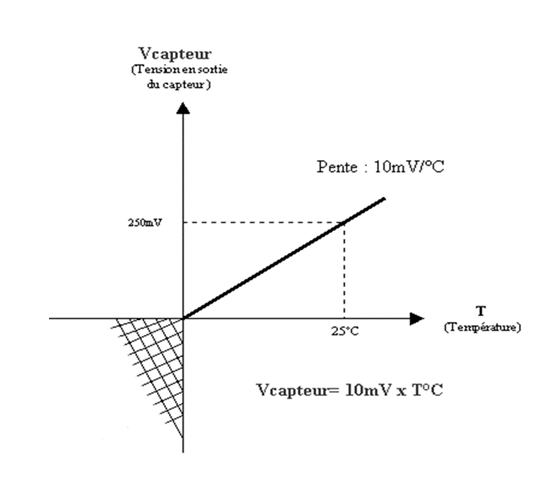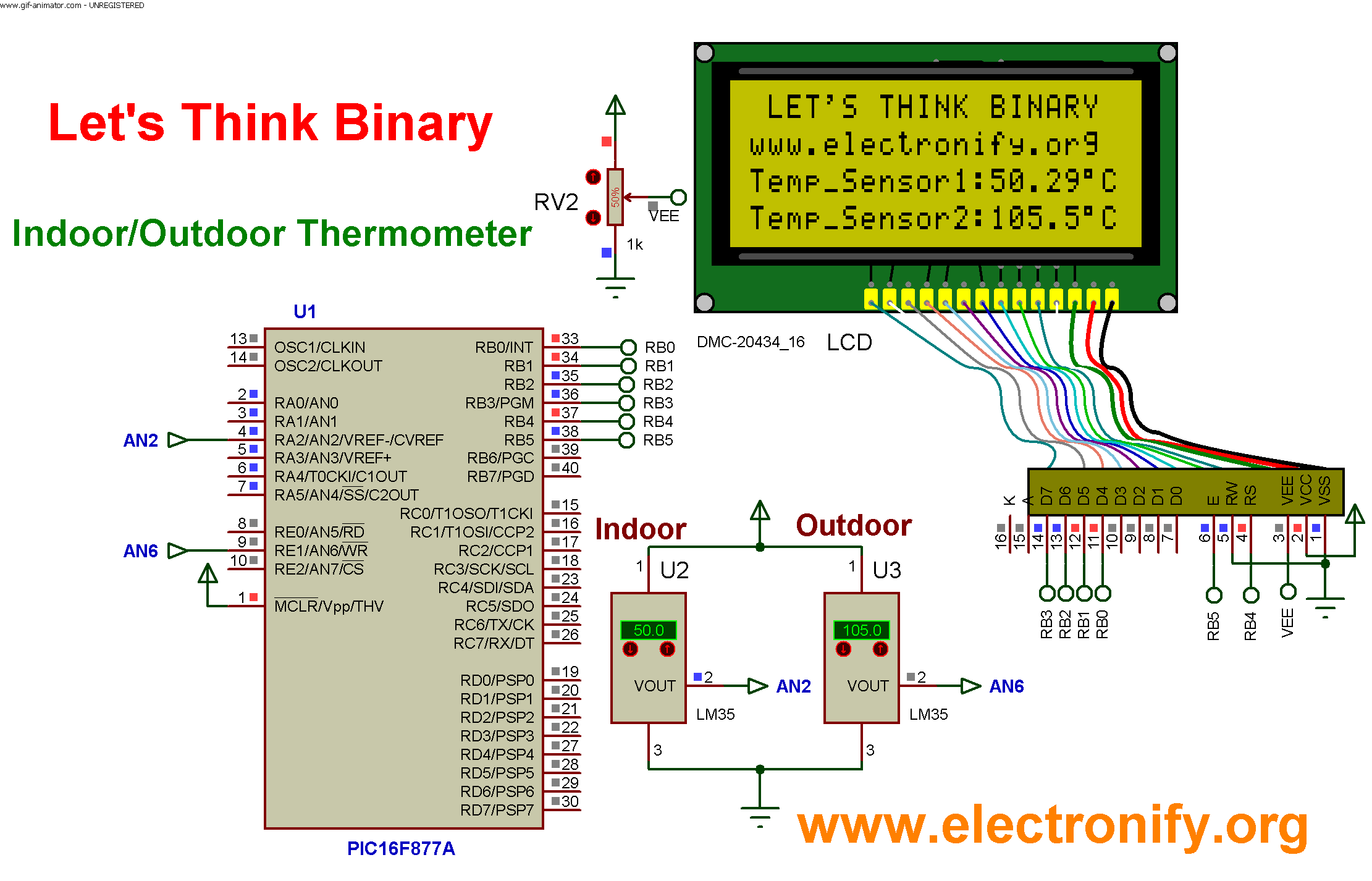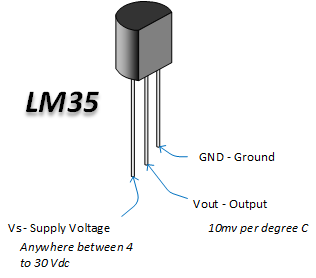This is a simple project showing you how to read LM35 analog temperature sensor using a PIC microcontroller and LCD 4×20 in Proteus ISIS. In this tutorial we will make a practical use of the ADC. We will use them to show current temperature using two LM35 temperature sensors.
The temperature sensors are connected to the ADC ports of the microcontroller, which takes in the analog signal and gives out digital values across specified ports.
Across the defined output port of the microcontroller, LCD 4×20 is connected with takes the values of the temperature sensors (Indoor / Outdoor) and displays them.
LM35 is a Three-Pins (Vcc,Output,GND) high precision temperature sensor having a resolution of 10mV/C starting at 0V (i.e. an output of 0V represents a temperature of 0C).
So :
10mV —> 1C
20mV —> 2C
500mV —> 50C and so on

ADC is an electronic circuit that converts continuous signals to discrete digital numbers. PIC16F877A microcontroller built in ADC (analog to digital converter) is used to measure analog voltage. The analog to digital conversion is done by the PIC ADC module. In the code, I’ve used the mikro C library function for ADC.
ADC Library provides you a comfortable work with the module.
Library Routines
- ADC_Init
- ADC_Get_Sample
- ADC_Read
ADC_Init
| Prototype | voidADC_Init(); |
| Returns | Nothing. |
| Description | This routine initializes PIC’s internal ADC module to work with RC clock. Clock determines the time period necessary for performing AD conversion (min 12TAD). |
| Requires |
|
| Example | ADC_Init(); // Initialize ADC module with default settings |
ADC_Get_Sample
| Prototype | unsigned ADC_Get_Sample(unsigned short channel); |
| Returns | 10 or 12-bit unsigned value read from the specified channel (MCU dependent). |
| Description | The function acquires analog value from the specified channel. Parameter channel represents the channel from which the analog value is to be acquired. Refer to the appropriate datasheet for channel-to-pin mapping. Note : This function doesn’t work with the external voltage reference source, only with the internal voltage reference. |
| Requires |
|
| Example | unsigned adc_value;…
adc_value = ADC_Get_Sample(2); // read analog value from ADC module channel 2 |
ADC_Read
| Prototype | unsigned ADC_Read(unsigned short channel); |
| Returns | 10 or 12-bit unsigned value read from the specified channel (MCU dependent). |
| Description | Initializes PIC’s internal ADC module to workwith RC clock. Clock determines the time period necessary for performing AD conversion (min 12TAD). Parameter channel represents the channel from which the analog value is to be acquired. Refer to the appropriate datasheet for channel-to-pin mapping. Note : This function doesn’t work with the external voltage reference source, only with the internal voltage reference. |
| Requires |
|
| Example | unsigned tmp;…
tmp = ADC_Read(2); // Read analog value from channel 2 |
You can view the library from this link
Double sensor interface Indoor/OutdoorThermometer using PIC16F877A Microcontroller (Code)
/*
* Project name:
LM35 Sensor (Temperature measurement)
* Copyright:
(c) lET'S THINk BINARY, 2017.
* Revision History:
V0.0
* Description:
A simple example of using the LM35 sensor.
Temperature is displayed on LCD.
* Test configuration:
MCU: PIC16f877a
Oscillator: 8.0000 MHz Crystal
SW: mikroC PRO for PIC
http://www.mikroe.com/mikroc/pic/
* NOTES:
- This Our Group (thanks to join and participate) :
https://www.facebook.com/groups/816450708460518/
- Facebook page (thanks to like and share) :
https://www.facebook.com/Lets-Think-Binary-1728910547340654/
- Youtube Channel (thanks to subscribe) :
https://www.youtube.com/channel/UCTIAzxEkyeA6HTvl_VHd-Tw
*/
// LCD module connections
sbit LCD_RS at RB4_bit;
sbit LCD_EN at RB5_bit;
sbit LCD_D4 at RB0_bit;
sbit LCD_D5 at RB1_bit;
sbit LCD_D6 at RB2_bit;
sbit LCD_D7 at RB3_bit;
sbit LCD_RS_Direction at TRISB4_bit;
sbit LCD_EN_Direction at TRISB5_bit;
sbit LCD_D4_Direction at TRISB0_bit;
sbit LCD_D5_Direction at TRISB1_bit;
sbit LCD_D6_Direction at TRISB2_bit;
sbit LCD_D7_Direction at TRISB3_bit;
// End LCD module connections
unsigned int temp_res = 0;
float temp;
char txt[15];
char *text;
void display_sensor1(){
temp_res = ADC_Get_Sample(2); // Get 10-bit results of AD conversion
temp = (temp_res * 5)/10.240; // Calculate temperature in Celsuis
FloatToStr(temp, txt); // Convert temperature to string
txt[5] = 0;
Lcd_Out(3,14,txt); // Write string in second row
Lcd_Chr(3,19,223); // Different LCD displays have different // char code for degree 178 (in practice) or 223 (for proteus simulation)
Lcd_Chr(3,20,'C'); // Display "C" for Celsius
}
void display_sensor2(){
temp_res = ADC_Get_Sample(6); // Get 10-bit results of AD conversion
temp=(temp_res * 5000.0/1023.0 )/10; // Calculate temperature in Celsuis
FloatToStr(temp, txt); // Convert temperature to string
txt[5] = 0;
Lcd_Out(4,14,txt); // Write string in second row
Lcd_Chr(4,19,223); // Different LCD displays have different // char code for degree 178 (in practice) or 223 (for proteus simulation)
Lcd_Chr(4,20,'C'); // Display "C" for Celsius
}
void main()
{
CMCON = 0x07; // Comparators OFF
ADCON1 = 0x80; // Configure PORTA & PORTE as analog
TRISA = 0x04; // Configure RA2 pin as input
TRISE1_bit = 1; // Configure RE1 pin as input
ADC_Init(); // Initialize ADC
Lcd_Init(); // LCD display initialization
Lcd_Cmd(_LCD_CURSOR_OFF); // LCD command (cursor off)
Lcd_Cmd(_LCD_CLEAR); // LCD command (clear LCD)
text = "LET'S THINK BINARY"; // Define the first message
Lcd_Out(1,2,text); // Write the first message in the first line
text = "www.electronify.org"; // Define the second message
Lcd_Out(2,1,text); // Write the message in the second line
Lcd_Out(3,1,"Temp_Sensor1:");
Lcd_Out(4,1,"Temp_Sensor2:");
//temp_res = 0;
do
{
display_sensor1(); // Dosplay thr tempedrature of sensor1
display_sensor2(); // Dosplay thr tempedrature of sensor2
Delay_ms(1000);
} while(1);
}
Double sensor interface Indoor/OutdoorThermometer using PIC16F877A Microcontroller (Schematic Diagram)

RESULTS :
Compile the PIC code and generate the HEX file from it. For the simulation with Proteus ISIS hit run button and then you will get above output.
So ,now we can see the LCD is displaying the Indoor and the Out door temperature. Now if you change the value of the two sensors then the value of temperature will change in LCD.
Resource :
You can download the MikroC Source Code and Proteus files etc from this link
This Our Group (thanks to join and participate) : https://www.facebook.com/groups/816450708460518/
Facebook page (thanks to like and share) :
https://www.facebook.com/Lets-Think-Binary-1728910547340654/
Youtube Channel (thanks to subscribe) :
https://www.youtube.com/channel/UCTIAzxEkyeA6HTvl_VHd-Tw

